The post Art in the Streets appeared first on UBC Okanagan News.
SHAWN SERFAS HAD A BIT OF A CIRCUITOUS ROUTE TO UBCO. After originally joining the fine arts program in 2004, he spent eight years as a lecturer, teaching painting and drawing. Then in 2012, Brock University in St. Catharines, Ontario, beckoned; at the time, they were building a new purpose-built 100,000 square foot facility that would house the dramatic arts, visual arts, music and studies in arts and culture. For Serfas, the prospect of helping build an art program with a large team was enticing and drew him to the other side of the country.
“During my tenure there, I helped establish the art school and build its profile. In my last year, I was head of the department and helped move the program into the future, and make connections with the community,” he says.
In the nine years he was at Brock, Serfas was able to connect with artists and art programs at many art schools in Ontario. He also created opportunities for his students to engage with lots of artists in New York and around southern Ontario.
“There are many great artists in that part of the country. It was a fruitful time, and I cherish those memories and the people.”
Then a position opened to teach painting and drawing at UBCO, and Serfas jumped at the chance to come back to the Okanagan. He has fond memories of the people at UBCO and the arts community.
“I’m thrilled to be back, and excited to build new bridges and foster new creative opportunities for students, faculty and staff.”
“A big part of my investment here at UBCO and in Kelowna is making sure we attract the best and brightest students to our Bachelor of Fine Arts program.”
He says that he is thankful to be able to spend the rest of his career in the Okanagan. “Even though I have many years left, I know this is home. This is where I’m going to stay and hang my hat.”
In his first year back, Serfas plans to experience the spaces again, to see what has changed and what remains the same. He has a passion to bring the best students to UBCO, and plans to continue making connections in the arts community to create opportunities for students.
“A big part of my investment here at UBCO and in Kelowna is making sure we attract the best and brightest students to our Bachelor of Fine Arts program.”
He adds that his number one desire is to build one of the best fine arts schools in the region.
“UBCO trains artists to be excellent at their disciplines. I want to make sure the university is recognized as having one of the best visual arts programs in Western Canada. I want to come to work every day and work with some of the most eager, vigorous and hungry students there are, and who really want to understand their creative voice and grow.”
He notes that he is still figuring out what that looks like in such a diverse department, work needs to be done to support all the other areas, and there is a lot of range in the fine arts and media studies programs.
“If I want to help build one of the best painting and drawing schools, the whole department has to be healthy as well.”
Intersections with teaching and artistic practice
Becoming a professor wasn’t a conscious decision for Serfas, but he found the engagement and conversations with students to be very enriching for his own practice. “Teaching can be hard, but when you’re with students who are excited about the material, that’s exciting to be able to help them.”
Serfas says although there are many rewarding things in life, perhaps one of the most rewarding is when a former student reaches out to thank you for pushing them so hard.
“You know you’re making a difference in their creative life. That’s pretty important work I think.”
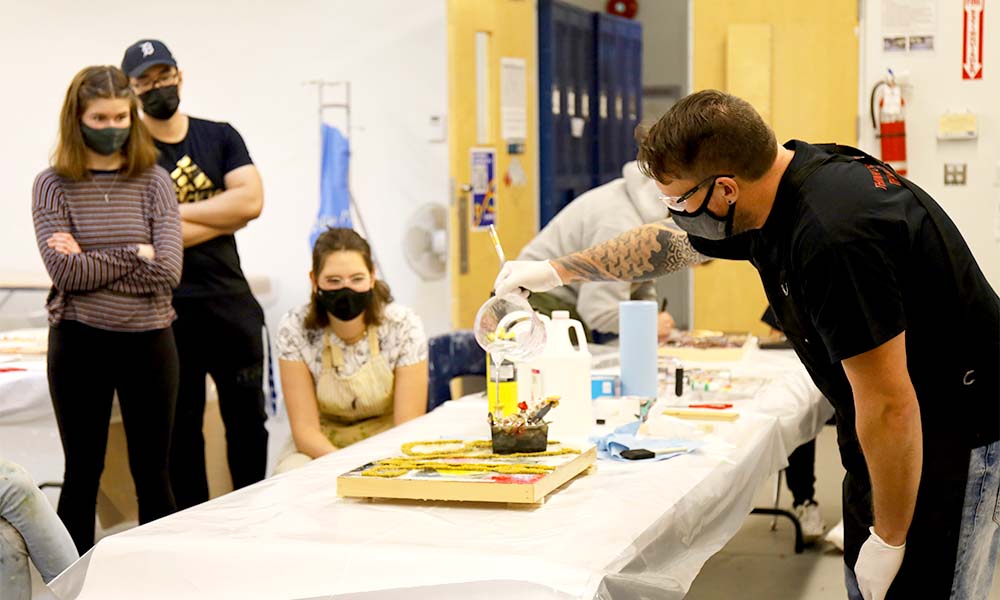
Shawn Serfas relishes his roles as teacher and creator.
As someone involved with his students, the community and his own practice, finding a balance can become a challenge, but Serfas says everything gets done effectively and efficiently when there’s a love of one’s profession.
“I really value being in the studio, so I set up blocks of time and don’t let anything interrupt that. I ensure I set up healthy boundaries and perimeters so my research doesn’t suffer.”
However, over time some of those boundaries have blurred; for example, one of the ways Serfas engages with his students is to get into the studio and paint alongside them.
“Our program is training students to become artists, so you need an artist to train them. Being artists ourselves showcases our value, and signals to students that we value our fields and creative expression, and the kind of investment we’ve made in our disciplines.
“If we can connect those dots where our creative energy and experience can be brought into the classroom, then it’s infectious.”
Serfas adds that for him, the most valuable professors were the ones who had a healthy and creative studio practice, where they were engaged in the making and questioning of life and their creative histories.
“If I could go back in time and see my 18-year-old self, I would say trust the people who are most passionate about their discipline. Trust them—they’re living and breathing it.”
“Stick to your dreams and everything will eventually fall into place.”But as Knight entered her fourth year of the program, she knew she was not going to graduate that year because she was short some credits. “The situation almost eclipsed my longing to take a particular creative writing course where students submit chapters for peer review throughout the term.” Knight knew the course would be instrumental to her future writing career, so she took an extra term to acquire the additional needed credits—a decision she says was worth it. “Did I forsake priorities and follow my ambition? Of course. And I’m glad I did it because I ended up completing my first novel and getting published a few years later.” Knight’s advice to students facing a similar challenge? “Stick to your dreams and everything will eventually fall into place.” She adds that although English was her chosen major, she also ensured she could benefit from UBCO’s variety of course options to get the most out of her time at university. Knight points to the theatre courses she took, which brought her to many impressive and enlightening performances in the community. “The shows, the artists and actors illustrated just how eclectic and informative creativity can be, and they opened up different avenues for which I could manifest my own imagination and artistic vision.” In a cultural studies course focused on media, groups were assigned to film a public service announcement to bring awareness to mental health. “To our surprise, our 30-second video ended up being accepted to air on Shaw TV that year, and since I’ve always struggled with anxiety myself, I was—and still am—proud to be a part of such an important message.” She adds: “These courses had me seeking inspiration from my environment, using different lenses in order to see beyond my habitual perspective.” During her time at UBCO, Knight also published her first piece through Papershell, a student anthology produced annually by fourth-year creative writing students. The piece was a stage play she completed in one of her courses. “All of this and more helped broaden my creative capacity, and being able to venture outside the subjective has greatly improved my writing. The knowledge I took away from my time at UBCO has proven invaluable to me as an artist and writer.” NOW A PUBLISHED AUTHOR After moving to Edmonton, one of Knight’s short stories was published for the first time in a literary magazine, Cicatrix Publications, while one of her paintings was featured in the Dying Dahlia Review. A year later she published a longer prose piece in The Deaf Poet’s Society titled “Elevate,” about two strangers opening up to each other about their psychological struggles while trapped in an elevator.
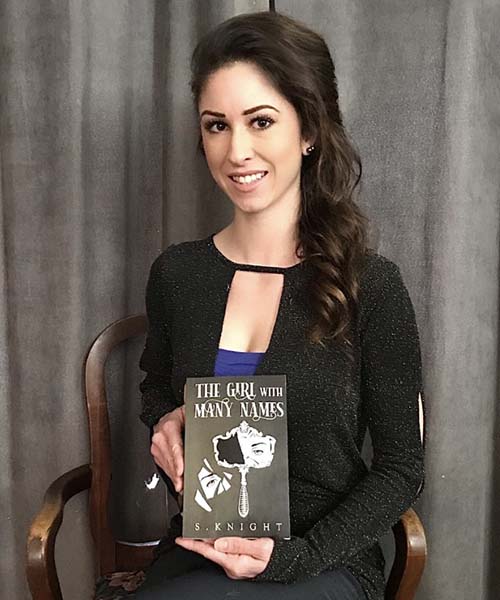
Samantha Gompf Knight.
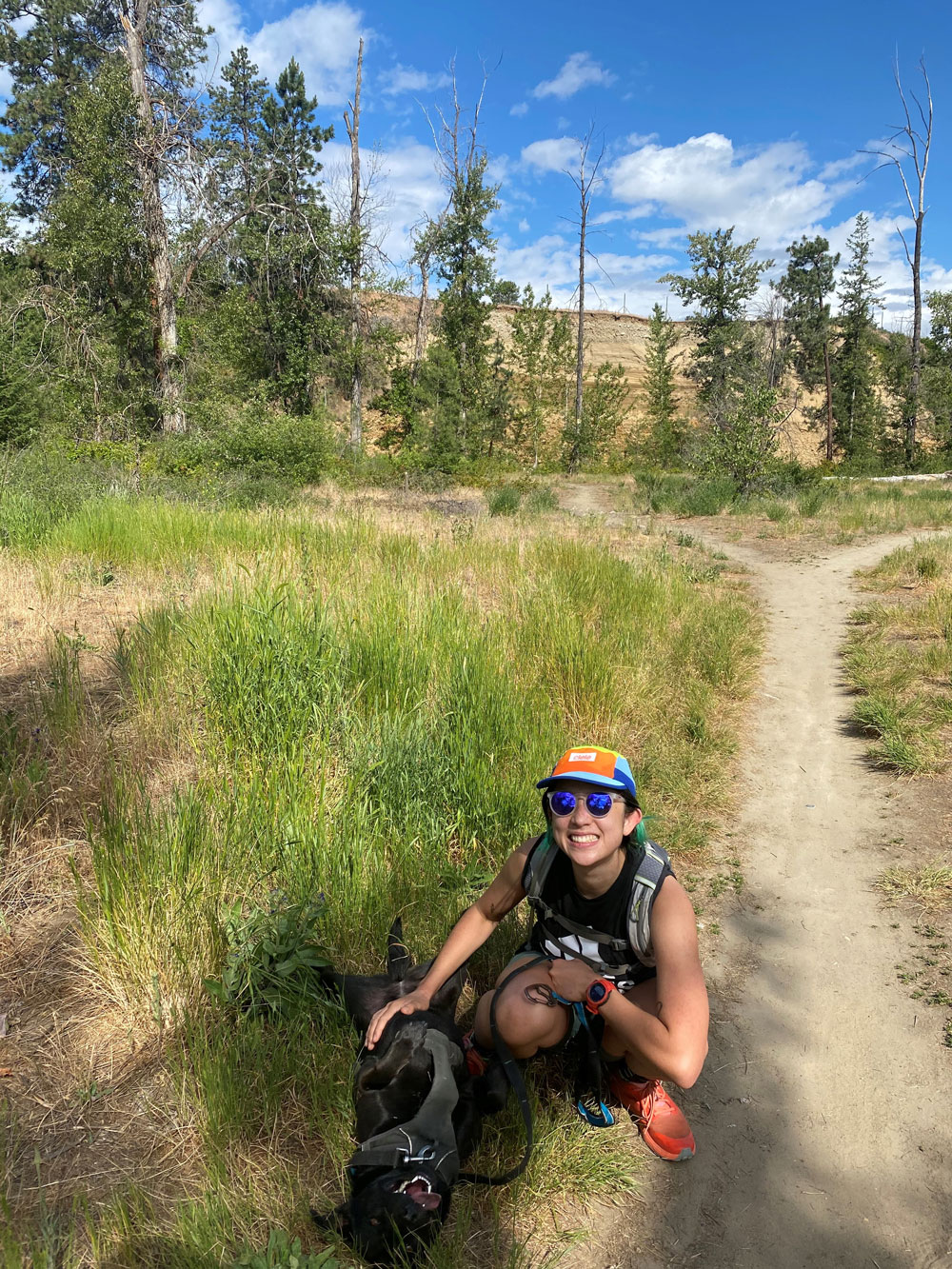
Melissa Plisic.
“With this format, I was able to express some part of myself. It was refreshing to make something with my own hands and to get away from my computer screen.”“It was liberating to be able to follow my own path while being supported by so many instructors. Going through university, you can start to sound more academic. The zines were a way to hold onto myself, and to present projects that were speaking from my own experiences.” After taking that class, Plisic was finally able to lay the uncomfortable feelings they had about their trip to rest. “I can look at myself and say, ‘yes you did these things because you wanted to help.’ And now I know they were not helpful. After doing this program I know have other work to do. “I can’t change the past, but I can do my best to dismantle global imperialist capitalism with the knowledge I now have.” COMMUNITY CONTRIBUTIONS Having lived in the Vancouver area their whole life, a change of scenery seemed appealing to Plisic when they applied to UBCO’s cultural studies program. But, there were challenges along the way. “I’m from the wet pacific northwest and a mixed-race Filipinx. Everything from the climate to the people in the Okanagan was a change for me. And I also faced racism, which was a defining factor of my experiences there. I like to think I came out stronger, different, with thicker skin.” They add: “Coming in as a mature student, I didn’t have the same orientation experience as a first-year student would. Feeling isolated and not finding a community when I arrived in my first year was hard.” Plisic eventually found the support they needed through UBCO’s Pride Resource Centre. “It was a place I hung out every day and slowly became more involved, eventually joining the board and hosting and organizing events.”
“Contributing to the larger sense of community made me feel like what I was doing was important. It was vital to have that space and see so many people interested in others’ experiences. It was a place for them to feel validated.”As part of the OutTalk discussion series, Plisic facilitated a round table discussion on biphobia, one of the first talks in the centre that was overflowing with attendees. “A lot of people want to talk about the issues of biphobia, bisexual erasure and the negativity towards bisexual and pansexual people.” Plisic had experienced biphobia within the queer community in Kelowna and felt the subject needed to be addressed at the discussions they attended. “Contributing to the larger sense of community made me feel like what I was doing was important. It was vital to have that space and see so many people interested in others’ experiences. It was a place for them to feel validated.” Plisic is now pursuing their master of arts in gender, race, sexuality and justice at UBC Vancouver, where they are focusing on anti-colonial environmental and food justice.
GROWING UP, MEGAN SMITH WAS ALWAYS CURIOUS about computers, art and technology. She was first introduced to home computers as a teenager.
“We had some computer science in high school, but most of the fun stuff was learned at home. I was influenced by the people around me. My parents gave me my first job formatting floppy disks.
“I became completely mesmerized by the Internet at a very young age before too many people had it in their homes. By the late 1990s I spent my whole student loan on a new computer and was teaching students in my dorm how to use the Internet.”
Smith says she’s always followed a path of blending creativity and science in her research.
“I’ve long been fascinated with the Internet and digital culture. Every time I make a new piece of work, my medium changes. I adapt to the message or the story I want to tell based on the data or technology I need to use to tell that story.”
Smith’s research projects use identity, mapping and geolocation to work towards understanding space within the digital domain. As a new media artist, she bridges physical computing within virtual and augmented reality environments. Her practice-based research blends with critical design methods to effectively build immersive environments.
“Where the Internet of Things can seem dry, I try to animate that with stories in new ways,” she says. “Much of my work references surveillance culture and I’m working to understand how those technologies track people and their identities.”
One of Smith’s previous projects, Pst! microCONTROL, involved an installation of five small clocks with digital faces that pulled data directly from Twitter, providing a window into a geo-located public space. By narrating social activity, the piece told a global story by placing various cities side-by-side.
Riding through Walls was an 18-month durational performance in the form of a cross-Canada cycle through Google Street View on a networked vintage ‘air wing’ stationary bike. This enabled Smith to propel herself visually through the map at the same speed as her pedalling. The project received some attention from the Royal Canadian Mounted Police (RCMP) and as a result, Smith is now involved in designing new tools for a virtual reality (VR) simulation training space for the RCMP, to be completed in 2023.
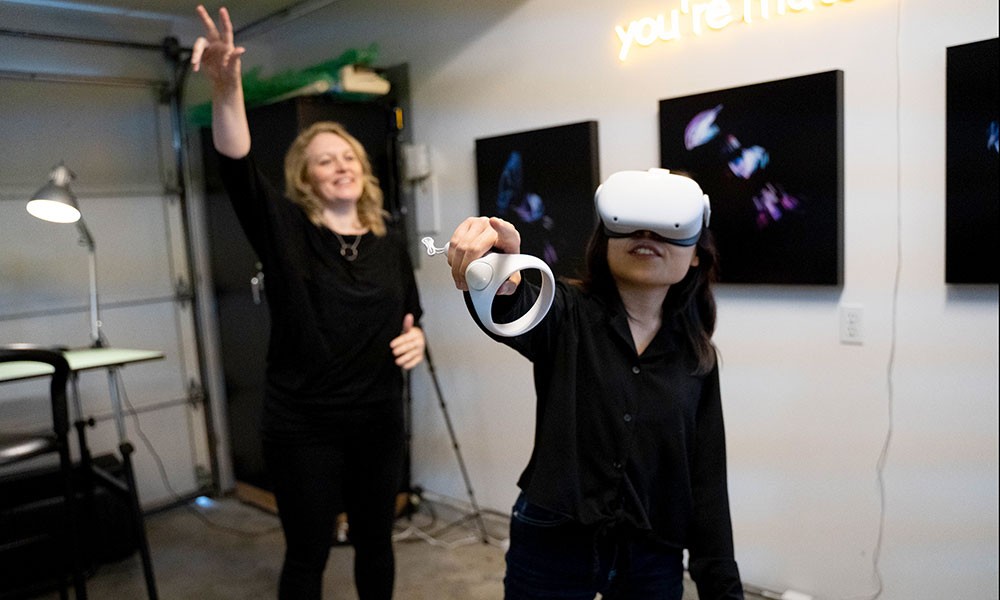
Dr. Megan Smith and PhD student Gao Yujie test out their research in the virtual environment.
“They saw me as a creative professor who was using new technologies in innovative ways and who understood virtual and augmented reality, so they asked me to work with them.”
The overarching goal of the project is to build good tools to help innovate police training in Canada. It’s one thing to play a game with a controller at home as a civilian, Smith explains, but it’s another to be a police officer using the controller for training. Smith is currently working on the development of a user study that will test the difference in learning outcomes between a controller used as a pistol in VR training against a custom-designed simulated service weapon applied in the same exercise. The research aims to reduce the risk of negative training that could be picked up from using a standard remote control.
Smith adds that when pistols are fired they can miss the target — stress or poor marksmanship can affect the outcome — but the hope is that VR can be a good tool for improving training.
“The RCMP, of course, take this outcome seriously, so being part of a team that’s building innovative solutions designed to reduce risk and improve training drive me to work on this,” Smith says.
REVAMPING THE BACHELOR OF MEDIA STUDIES
Smith was drawn to UBC Okanagan by the idea of having an expanded research team, and the blend of digital visual arts and media studies programs in the Faculty of Creative and Critical Studies. She was previously part of developing the creative technologies program at the University of Regina, and the idea of developing the media studies program at UBCO seemed like the next logical step.
While the Bachelor of Media Studies (BMS) has been offered at the campus for the last four years, a few years ago it became clear that the program needed some revisions to meet the needs of students. Over the last year, Smith has been working on those changes, creating a clear computational arts program that offers a streamlined set of computer science and critical thinking skills aimed at code-based art and design in creative arts and digital humanities.
Smith notes that while there were no programs like media studies when she went to university, a need for this area was beginning to arise through a shift in society. There is a demand for teaching across a blended space of art and design, science, computer coding, engineering, and creative thinking to ensure careers for future industries.
“All of the tools that we’re accessing through our phones and screens, all of this needs creative thinkers who are able to do a bit of all of these things.
“We’re going through a massive change as we enter the next evolution of the Internet, and people working in this area will be equipped to make those changes. They’re being trained to acquire hands-on skills. But more than that, they understand the cycle of innovation that’s taken place over the last 30 years.”
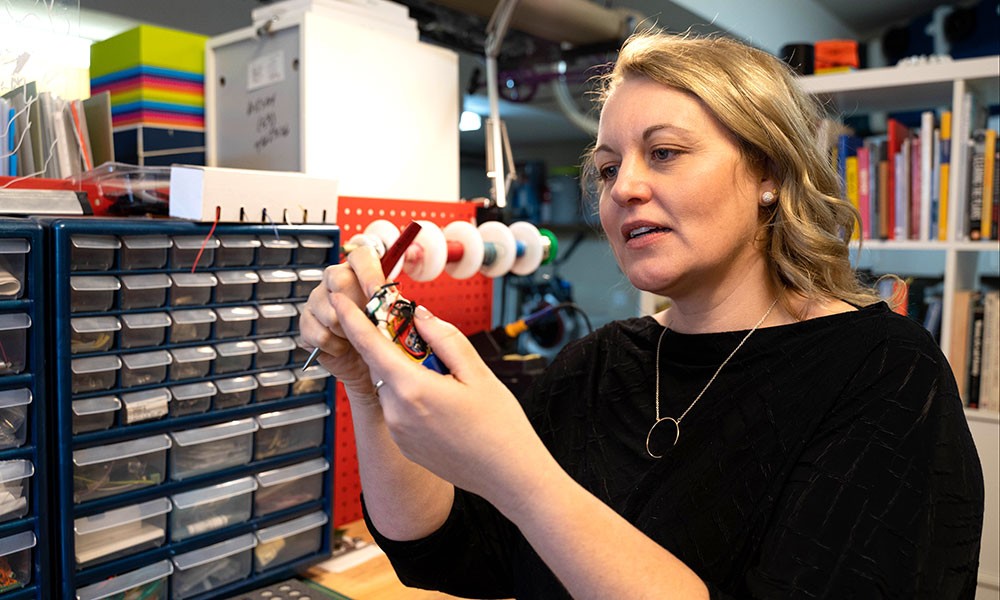
Dr. Megan Smith inspecting the virtual reality OC Spray prototype.
Smith adds that programs like the BMS provide students with the ability to understand critical choices that have been made in the past, including citizen journalism and algorithmic and design choices by major companies — and the consequent effects on mainstream media. These topics are taught to students in combination with how to access readily available electronics, how to build them into smart systems, how to use code picked up through courses, and how to visualize and draw from imagination.
“On top of that they know how to work on a team,” Smith says. “They may not be experts in all areas but they can work across areas and usually pick up a passion in one area.”
Some students end up focusing on creative coding; others are better at physical computing, graphic design, marketing or project management.
“We need that combination of people in order to make the projects of the future succeed. It’s impossible to make these complex projects on your own — you need a team. Each person can understand a little bit of what the others are doing and then bring their expertise to the table.
“That’s how I was brought into amazing research projects, and that’s what I hope for when I teach students,” says Smith. “In teaching our students, from the beginning I create projects that encourage collaboration, so that by the end they can work together to build spectacular projects. By the time students leave university, they are ready to launch into their own space, to join or form teams and they know how to thrive within that dynamic environment.”
